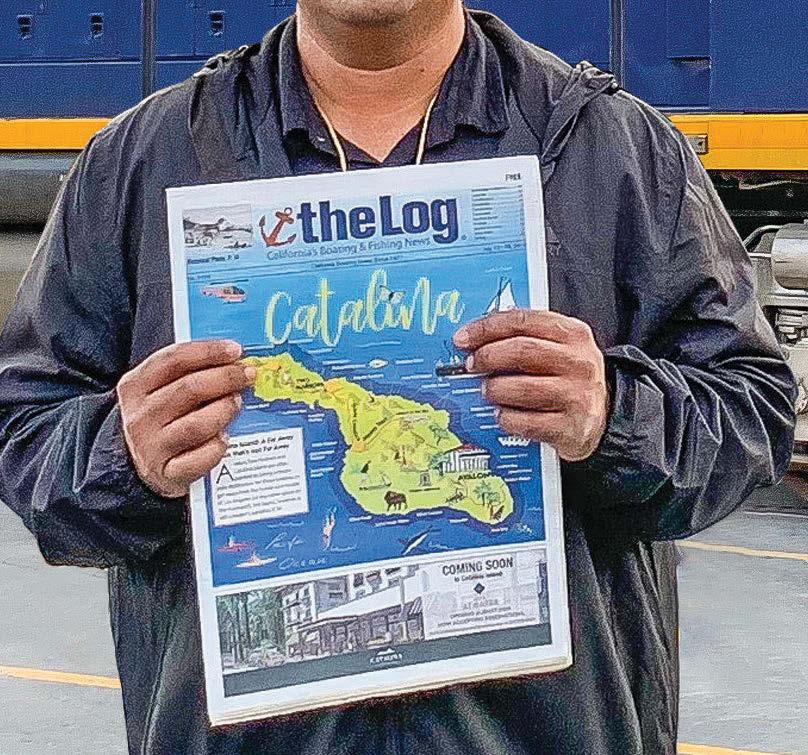
7 minute read
News Briefs
WORLD NEWS news briefs
By Jordan B. Darling
LOCAL Imperial Beach Pier Reopened Sept. 18
SAN DIEGO— The Port of San Diego and the City of Imperial Beached reopened the Imperial Beach Pier on Sept. 18 after a fi ve-day closure. On Sept. 13, the city reported that a pier piling was fl oating in the water, and Imperial Beach lifeguards closed the pier because of the structural damage. It is unclear how the piling was damaged, but it is assumed it was most likely due to surf and environmental conditions. After an inspection, it was determined that the pier did not suffer damage to the structural integrity of the pier, and it was allowed to reopen. The port’s engineering department and consultants are working on a repair schedule for the broken piling.
Port of San Diego Adds Two New Restaurants to Seaport Village
SAN DIEGO— Gladstone’s and Shorebird will join the restaurants in Seaport Village. These are the 19th and 20th leases approved by the Board of Port Commissioners as part of the revitalization of Seaport Village. Gladstone’s is a historic beachside restaurant founded in Malibu in 1972. Gladstones offers classic seafood dishes, including fi sh plates, king crab, Maine lobster, etc. This will be Shorebird’s third location offering coastal fl avors and a relaxed vibe.
“Seaport Village is attracting some major regional players in the food and beverage space – particularly among renowned casual dining and contemporary casual restaurants like Gladstone’s and Shorebird,” said Chairman Michael Zucchet, Port of San Diego Board of Port Commissioners, in a Sept. 15 press release. “Together, these latest additions to Seaport Village’s mostly locally-owned and operated lineup will bring even more excellent options to our San Diego Bay waterfront for locals and visitors to enjoy.” Both restaurants will begin construction in summer 2022 and are set to open fall of 2022.
SANTA BARBARA— The Harbor and Seafood Festival set for Oct. 16 has been canceled for 2021 due to the COVID-19 pandemic. The festival is a celebration of some of the world’s best seafood and the hard-working people that harvest seafood from local waters. “The Harbor & Seafood Festival is an iconic Waterfront event,” said Mike Wiltshire, waterfront director for Santa Barbara, in a newsletter from the city. “It’s a ton of fun, and we were really looking forward to it this year, but with signifi cant COVID cases, it’s just not an appropriate time to have 10,000+ people in close quarters in the Harbor. I’ve got high hopes for getting back to this, and all our regular events, in the coming year!” Even though the festival is canceled, the Commercial Fishermen of Santa Barbara and Get Hooked Seafood will have live lobster for sale and chef-made spiny lobster dishes to eat on the Maritime Museum’s front patio, Saturday, Oct. 23, from 1-4 p.m.
NATIONAL/INTERNATIONAL San Luis Reservoir Algal Bloom Increase to Danger Advisory
SACRAMENTO— On Sept. 7, the Department of Water Resources urged people to avoid physical contact and avoid eating fi sh or shellfi sh from the San Luis Reservoir in Merced County until further notice due to the presence of blue-green algae. Lab results released in early September showed an increase in toxin levels and placed a danger advisory to avoid the algal scum. Exposure to toxic blue-green algae, cyanobacteria, can cause eye irritation, allergic skin rashes, mouth ulcers, vomiting, diarrhea, and cold-and-fl u-like symptoms. The algal bloom can accumulate into mats and scum, and form foam along the surface and shoreline in a range of colors from blue, green, white, or brown. State regulations recommend avoiding any physical contact or ingestion of the water, including for pets and livestock. Seek medical treatment immediately if you come in contact with the blue-green algae toxins. To learn more, visit the California Department of Water Resources, blue-green algae bloom website at https://water.ca.gov/ What-We-Do/Recreation/Algal-Blooms.
House of Representatives Passes Measure to Create More Artificial Reefs
WASHINGTON DC— The House of Representatives approved a measure to provide opportunities for retired Navy ships to be considered for artifi cial reeds. The measure was included as an amendment to the National Defense Authorization Act for Fiscal Year 2022. The amendment is based on the Reusing Equipment for Environmental Fortifi cation Act introduced by Florida Representative Maria Salazar. The REEF Act will increase the opportunity for retired naval vessels to be considered for artifi cial reefs and will help create new marine ecosystems and recreational fi shing opportunities. “As a representative from a coastal district, I know fi rsthand that we must do more to support our marine ecosystems,” said Salazar in a Sept. 22 press release. “I’m proud to introduce a bill that gives us the opportunity to accomplish that by giving our retired navy ships a new purpose, all while creating new recreational opportunities for fi shermen and divers that boost local economies.”
Fast Facts
From page 4

dios, and stoves of Los Angeles.
Formerly known as the Boulder Dam, Hoover Dam began construction under President Herbert Hoover’s administration and was finished during the Roosevelt administration (which is when the name was changed to Hoover Dam).
In 1933, President Hoover was succeeded in the White House by Franklin Roosevelt and the new secretary of the interior, Harold Ickes. The latter was not a fan of Hoover and declared that the dam returned to its original name, the Boulder Dam.
Americans blamed President Hoover for the Great Depression, tagging negative associations onto his name. As a result, the two names were used interchangeably, and the preference was often dependent upon the person’s political leanings.
In April 1947, President Harry Truman officially confirmed that the dam would carry on in Hoover’s name as the Hoover Dam.
When the construction of the dam was completed in 1935, it became the tallest dam in the world, standing at 726.4 feet, according to usbr.gov.
The electricity generated by the dam is a secondary perk of its purpose. The main principle for the dam was the collection, preservation, and distribution of water, the most valued commodity for the west.
Under the Federal Reclamation Bureau’s instructions, Hoover Dam had become one part of a much larger plan for a multipurpose water development project that tamed the Colorado River for the growing number of western farmers, ranchers, and city dwellers.
Before there was the Hoover Dam, water had once flowed freely to the ocean but is now seized by the 115-mile-long Lake Mead in Nevada.
The massive aqueducts of the Hoover Dam channel millions of gallons of Colorado River water to California, where it continues to flow from Los Angeles faucets and irrigates vast stretches of fertile cropland.
Hoover Dam generates on average about 4 billion kilowatt-hours of hydroelectric power each year for use in Nevada, Arizona, and California, according to the Bureau of Reclamation; that is enough power to serve 1.3 million people.
By using the Hoover Dam, the federal government made an endeavor to demonstrate that the arid climates of any region once called the Great American Desert, a term used to describe the Great Plains west of the Rocky Mountains, was no serious obstacle for the development and settlement.
Nevertheless, while fast-growing cities across the west, such as Los Angeles, Las Vegas, and Phoenix, face increasing difficulties in accessing the water they need, it remains to be seen if the Great American Desert might still control its restrictions for western growth.




Reader Q&A By Jordan B. Darling
RE: Fast Facts: Humphrey
Bogart the Sailor (JANURARY 2017)
Q“The Santana in Key Largo was not a 55 ft. sailing yacht. What kind of boat was it?” —George Sheffi eld George Sheffi eld
AHumphrey Bogart did own a 55-foot sailing yacht named the Santana. The boat inspired the name of his fi lm company Santana Productions which was founded in 1948 and then became the name of a cabin cruiser featured in the 1948 fi lm Key Largo, according to lingerandlook.com. Cabin cruisers generally have one or two motors and are built for long-distance cruises, waterway tours, and traveling along coastal waters. They are generally equipped with full accommodations in the hull and tend to be between 17 and 55 feet in length, according to boattrader.com.
55-foot sailing yacht named the Santana. The boat inspired the name of his fi lm company Santana Productions which was founded in 1948 and then with full accommodations in the hull and tend to be between 17 and 55 feet in length, according to boattrader.com.
Have a question you want The Log to Have a question you want The Log to answer? Send us an email at thelogedianswer? Send us an email at thelogeditor@thelog.com. tor@thelog.com.






